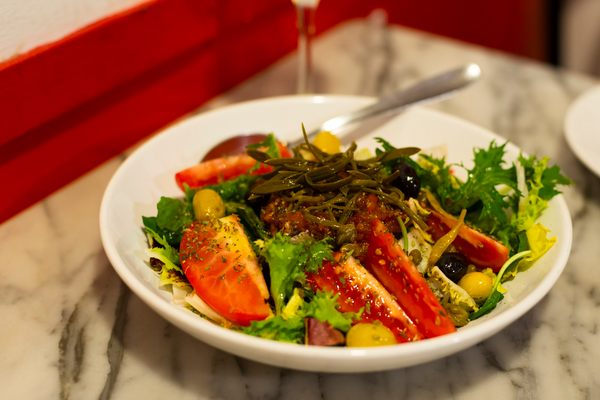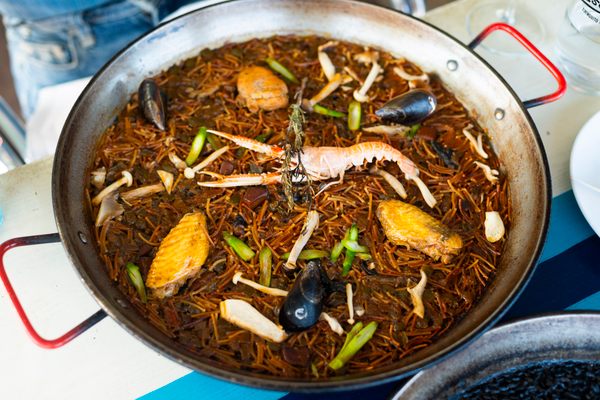The Regional Chinese Cuisine Linked to an Ancient Assassin
A king died after being served up a murderous fish in present-day Suzhou.

In Suzhou, China, hundreds of ancient canals run parallel to the city’s streets, intersecting them beneath arched stone bridges. It’s what’s earned the city the nickname “Venice of the East.” But Suzhou is also part of a larger area south of the Yangtze River, and is known by another moniker: “The Land of Fish and Rice.” “Neither fish nor rice can live without water,” says “Cathy” Chen, a Suzhou tour guide who was born and raised in the Yangtze River Region. “So Suzhou is a water city.”
Suzhou owes its existence to these waterways, and particularly to the availability of fish. While fish gave life to Suzhou’s cuisine, it was also responsible for the death of the former king more than 2,500 years ago.
Back during ancient China’s Spring and Autumn Period (approximately 771 to 476 B.C.), Prince Guang of Wu wanted to usurp the throne of his uncle, King Liao. So he recruited an assassin named Zhuan Zhu for assistance. Knowing that his uncle was both a fan of seafood and not an easy target, Guang decided to disguise Zhuan Zhu as a chef. “Guang first sent the assassin to nearby Lake Taihu, where he spent three full months learning the art of cooking and dressing large lake fish,” says Chen. “The fish he prepared would then conceal a tiny sword in its innards.” That culinary process involved learning techniques such as smoking and roasting, as well as cleaning and filleting fish properly—which also gave the assassin the perfect opportunity to hide a weapon inside.
After King Liao won a skirmish against a neighboring state, Prince Guang offered to host a celebratory banquet for him. Liao accepted. “With appropriate fanfare, Zhuan Zhu brought the meal’s pièce de résistance to the table,” Chen says. By some accounts, a thick sauce covered the boned fish. It disguised the dagger that Zhu slipped inside, and instead called Liao’s attention to the fine dish’s presentation. “The assassin-chef quickly withdrew its hidden sword and stabbed Liao twice, fatally, before himself being killed by the king’s bodyguard,” Chen says. “Prince Guang’s own soldiers, hidden nearby, made quick work of Liao’s loyal guard.”
Following the assassination, Prince Guang seized the throne and became known as King Helü. “It was Helü who ordered that a new capital city be built for the Wu State,” says Stephen L. Koss, the author of Beautiful Su: A Social and Cultural History of Suzhou, China. “And thus in 514 B.C., the city of Suzhou was born.”

From there Suzhou developed as a cultural center, with cuisine as one of its main pillars (the others being Suzhou silk, gardens, and handicrafts). Lake Taihu—an 869-square-mile freshwater lake (China’s third-largest) that sits on the outskirts of Suzhou—has been feeding local residents for millennia. Everything from silver fish to shrimp, eels, and plants such as chestnuts and lotus roots stem from its waters. It’s also played a large role in the development of Suzhou-style cuisine, a local variation of Jiangsu or “Su,” one of China’s Eight Culinary Traditions.
Over the years, Suzhou dishes have become known for their subtle flavors and an emphasis on ingredients including braised pork, bamboo shoots, and a paste made from broiled and stir-fried eels. Entrées are highly flavorful and typically sweeter than other regional Chinese cuisines, with a stylized look that at once embodies visual storytelling and distinct culinary craftsmanship.
One of these dishes is song shu gui yu. The “squirrel-shaped mandarin fish” is boned, and then its flesh is cut with a diamond-shaped knife pattern. It’s then seasoned, battered, and deep-fried. Crispy on the outside and soft and tender on the inside, it gets its name both from its elaborate appearance and for the squealing sound it makes when covered in hot sweet-and-sour sauce. “It’s a fish that looks like a squirrel,” says Jerry Gao, a chef at the InterContinental Suzhou. “The fish meat is spread out like gold fur, and its head and tail are both turned up.”
Song shu gui yu has become so popular that it appears on menus countrywide, served from Beijing to Guangzhou with all the aplomb of royalty. “When guests from other areas of China [visit], the first thing they want to try is song shu gui yu,” says Pan Xiaomin, head chef of Suzhou’s SCHotel Group. Within Suzhou, it’s gradually becoming more than an occasional splurge, too. “Squirrel-shaped mandarin fish is an expensive dish, because mandarin fish is expensive and the way to make song shu gui yu is not easy, therefore only on special occasions, we eat it,” says Chen. “Since our living conditions are becoming better and better, many people [are now able to] afford to pay for this dish and enjoy it.”
Both Xiaomin and Gao describe song shu gui yu as the epitome of Suzhou cuisine. It’s a dish, as Goa describes, that utilizes “fresh ingredients and fine-cutting skill.” It’s so masterfully diced and unusual in appearance that some people hold that it could be a well-refined version of Zhuan Zhu’s famous dagger fish, over 2,500 years on.
The story of Zhuan Zhu and his “sword of bravery”—known as yú cháng jiàn (meaning “fish-belly sword” or “fish-intestine sword”)—became legendary, and its authenticity is recorded in Chinese historian Sima Qian’s ancient text, Records of the Grand Historian. Yet the famed assassin’s exact fish recipe has been lost to time, though variations persist.
“I’ve seen one story that says Zhuan Zhu had sliced the fish and covered it in a brown sauce to help hide the sword,” says Koss. “But it’s not generally connected by most Suzhou people to song shu gui yu.” According to Chen, “One paper did write that roast Taihu mei qi yu (“anchovy from Lake Taihu”) is the prototype of song shu gui yu, but can you see song shu gui yu hiding a tiny yú cháng jiàn? I think only roast fish could [conceal a dagger].” There’s also the Shanghai Daily, which briefly notes that the baked and sauce-covered Zhuan zhu yu zhi (“fish swallowing a sword”) is today’s version of Zhuan Zhu’s murderous masterpiece.

While people dispute whether song shu gui yu has any relation at all to Zhuan Zhu’s killer fish, it’s well-accepted that The Qianlong Emperor popularized the squirrel-inspired delicacy in the 18th century. Each time Qianlong traveled to Suzhou from Beijing on one of his “Southern Inspection Tours,” which oversaw the area’s Imperial progress, he stopped by the Songhelou restaurant to order it, often in disguise. “Qianlong really enjoyed it,” says Xiaomin. “His endorsement is why this dish is so beloved.”
Endorsement isn’t exactly something that the fallen King Liao was in a position to provide. That’s why Zhuan Zhu’s “assassin fish” has been surpassed by more favored dishes such as song shu gui yu. It’s only speculation that one spawned the other, but the two do share an undeniable connection: That Suzhou chefs sure know their way around knives.
Gastro Obscura covers the world’s most wondrous food and drink.
Sign up for our regular newsletter.


























Follow us on Twitter to get the latest on the world's hidden wonders.
Like us on Facebook to get the latest on the world's hidden wonders.
Follow us on Twitter Like us on Facebook